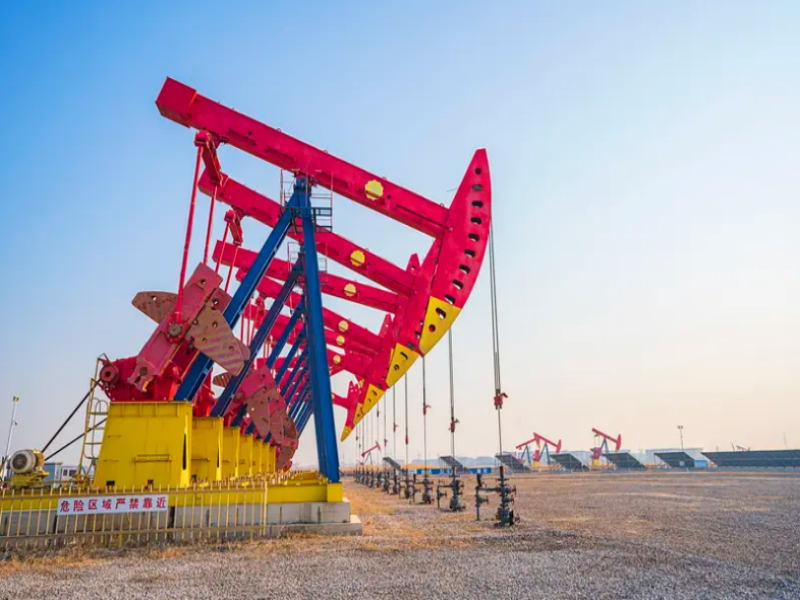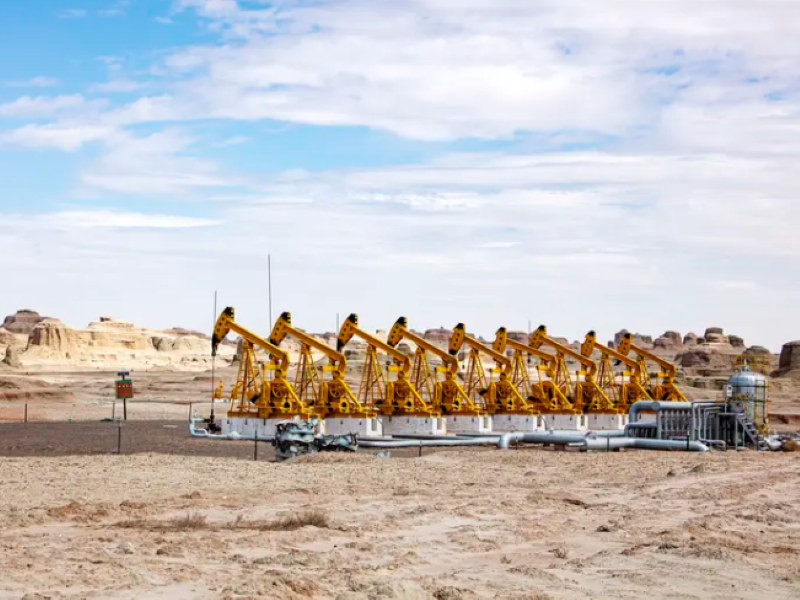In the oil fields, people can often see rows of mechanical devices ups and downs rhythmically, as if they are kowtowing. This is commonly known as the “kowtow machine”, the scientific name beam pump. It is one of the main types of pumping units currently used in oil fields and plays a very important role in the field of oil extraction.
Table of contents:
Composition of beam pump
Working principle
Classification
Status and role in oil extraction
Reference materials
Ⅰ. Composition of beam pump:
Beam pump is mainly composed of four parts: Donkey head—travel beam—connecting rod—crank mechanism, gear box, power equipment and auxiliary equipment.
Donkey head-travel beam—connecting rod-crank mechanism: The donkey head is the part of the pumping unit directly connected to the wellhead light rod. It has a unique shape and is responsible for driving the light rod to reciprocate up and down during work. The tour beam is like a huge lever, one end is connected to the donkey's head, and the other end is connected to the crank through a connecting rod. The crank rotates under the drive of power, and the rotating movement is converted into the swing of the beam up and down through the connecting rod, which in turn drives the donkey head to work. This mechanism is the key moving part of the pumping unit to lift underground crude oil to the ground.
Gear box: The output of power equipment is usually high-speed rotation, while the work of the oil pump requires low-speed, high-torque movement. The role of the reducer is to change the high-speed rotation of the power unit into the low-speed rotation of the crank of the pumping unit. Through gear transmission, the speed is reduced and the torque is increased to meet the needs of the pumping unit.
Power equipment: Generally, electric motors are used as the power source to provide continuous and stable power for the operation of the pumping unit. The electric motor converts electrical energy into mechanical energy and drives the gearbox and the entire pumping unit system to work.
Auxiliary equipment: Including various brackets and bases, which are used to support and fix the various components of the pumping unit to make it stable during work; There are also brake devices to keep the pumping function in any position for easy maintenance and overhaul; And balancing devices to enable the power function to work within a smaller range of load changes, reducing energy consumption and equipment wear.
Ⅱ. Working principle:
When working, the rotation of the motor is turned into the up and down movement of the donkey's head through the gearbox and crank connecting rod mechanism.
The specific process is: The high-speed rotational movement output by the motor is first transmitted to the gearbox, and after the gear is decelerated and the torque is amplified in the gearbox, it is transmitted to the crank. The crank moves in a circular motion, and the circular motion of the crank is converted into the upper and lower swing of the beam through the connecting rod. The swing of the beam drives the donkey's head to move down, and the donkey's head is then driven up and down by the light rod and the oil pumping rod. The plunger of the underground oil pump moves up and down. When the plunger goes up, the pressure in the pump decreases, and the crude oil at the bottom of the well enters the pump through the suction valve of the pump under the action of the pressure difference; When the plunger goes down, the pressure in the pump rises, and the crude oil is squeezed out of the pump body and enters the tubing through the discharge valve, thereby continuously extracting the crude oil from the well out of the well.
Taking an oil production well as an example, the beam pump used in the well continuously extracts crude oil from deep underground in accordance with this working principle every day, contributing to the crude oil production of the oilfield.

Ⅲ. Classification:
(1) Classification by balanced method:
Beam balance type: A balance weight is installed at the tail of the beam, and the balance of the pumping unit is achieved by adjusting the position and weight of the balance weight. The structure of this balancing method is relatively simple, but the balancing effect is limited. It is suitable for some small oil pumping units or occasions where the balance requirements are not high.
Crank balanced type: A counterweight is installed on the crank, and the centrifugal force generated by the counterweight when the crank rotates is used to balance the load of the pumping unit when it is working. This balancing method can be better adapted to different working conditions, has a better balancing effect, and is widely used.
Composite balance type: Combining the characteristics of beam balance and crank balance, balance weights are installed on both beam and crank to further improve the balance effect, which can meet the balance needs of some large pumping units or complex working conditions.
Pneumatic balanced type: The pressure of the gas is used to achieve balance. By setting up a gas tank and other devices on the pumping unit, the gas pressure is adjusted according to the working state of the pumping unit to achieve the purpose of balancing the load. This balancing method has a fast response speed and can better adapt to changes in load, but the equipment is relatively complex and the cost is higher.
(2) Classification by structure type:
Conventional beam pump: The donkey head and crank connecting rod mechanism are located at the front and rear of the bracket, and the balance angle is zero. It has a simple structure, easy to manufacture and maintain, and is the most common type of beam pump, which is widely used in various oil well mining.
Front-mounted beam pump: The donkey head and crank connecting rod mechanism are located in front of the bracket. This structure moves the center of gravity of the pumping unit forward, which improves the force condition of the pumping unit to a certain extent, and is suitable for some specific oil well layout and mining requirements.
Out-of-phase beam pump: The donkey head and crank connecting rod mechanism are located at the front and rear of the bracket, but the balance angle is not zero. Compared with the conventional type, its motion characteristics are different, and under certain operating conditions, the efficiency and working performance of the pumping unit can be improved.
Double donkey head beam pump: The donkey head and crank connecting rod mechanism of the hanging light rod are located at the front and rear of the bracket. During the one-stroke process, the length of the rear arm and the length of the connecting rod are not constant. This structural design enables the pumping unit to better adapt to different load changes and improve pump efficiency when working, especially for some heavy oil wells or deep well mining.

Ⅳ. Status and role in oil extraction:
Beam pump belongs to the rod type of oil production equipment in terms of oil production method, and occupies an extremely important position in the entire field of oil extraction. At present, on a global scale, beam pump accounts for a high proportion of oil production equipment. Taking my country as an example, its usage accounts for about 90% of all oil production wells.
The reason why it is widely used is mainly because it has the advantages of simple structure, easy manufacturing, and easy to use. Even in complex and harsh oilfield environments, such as high temperature, high pressure, sand and dust, it can operate around the clock for a long time and has extremely high reliability. In the Daqing oilfield, many oil wells have been mined for decades, and beam pump has always been operating stably, which has made great contributions to the continuous high-yield and stable production of the oilfield.
However, beam pump is not perfect. It has some disadvantages, such as the large acceleration of the movement of the suspension point of the donkey's head, which will cause a greater impact on the sucker rod and the oil pump, shortening the service life of the equipment; The balance effect is relatively poor, resulting in higher energy consumption; Lower efficiency, especially during long strokes, the volume is large and bulky, and the difficulty and cost of installation and maintenance increase. But despite this, with its many advantages, it is still the most widely used type of pumping unit in oil extraction. With the continuous progress of science and technology, the improvement and optimization of beam pump is also continuing to further improve its performance and efficiency and better serve the petroleum extraction industry.
Reference materials:
PetroChina "Artificial Lifting to "Invite out" the Oil"
"Long-term operation example of beam pump in Daqing Oilfield"

